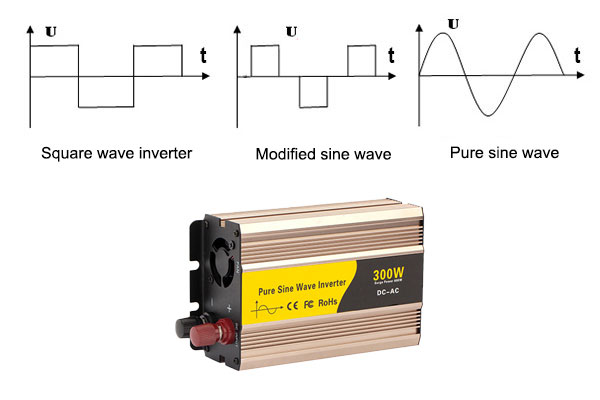A pure sine wave inverter is a kind of inverter, that is a power electronic device that transforms DC power (power battery, storage battery) into AC power, and the sine wave inverter completes the inverter task through the on/off of power semiconductor devices according to a specific law. Pure sine wave inverter is widely used in microcomputer systems, communication systems, home, aviation, emergency, communication, industrial equipment, satellite communication equipment, military vehicles, medical ambulances, police cars, ships, solar and wind power generation field,s and other places that need emergency backup power.
What are the features of a pure sine wave inverter?
- Pure sine wave output, suitable for TV sets, refrigerators, induction cookers, electric fans, microwave ovens, air conditioners, and other household equipment.
- Microcomputer (CPU) control technology, superior performance.
- Ultra-wide input voltage range, high-precision output, and fully automatic voltage stabilization.
- Built-in overload, short-circuit, over-voltage, under-voltage, over-temperature protection functions, high reliability.
- Simple and clear LED display, upgradeable to the full digital LCD display, easy to observe machine status.
- Power supply time can be arbitrarily configured according to different requirements.
- Pure sine wave inverter adopts valve-regulated maintenance-free lead-acid battery with intelligent battery management, over-charge and over-discharge protection to prolong battery life.

What is the difference between a pure sine wave inverter and a power inverter?
A pure sine wave inverter is suitable for any inductive load and resistive load, inductive load includes all kinds of equipment with AC motor refrigerator washing machines, etc. The power inverter is suitable for lighting lamps, watching TVs, electric heaters, and other resistive loads. Pure sine wave inverter, functional parameters require strict, higher prices, used for electronic circuits with high requirements for waveform parameters, while the power inverter is a heterogeneous waveform of a sine wave, square wave, miscellaneous wave, and other components, for general appliances can be used, the price is lower.
The difference between a pure sine wave inverter and a power inverter is that the output voltage waveform is different. A pure sine wave inverter is suitable for all appliances, and a power inverter is suitable for pure resistance appliances such as an electric stove.
Pure sine wave inverters produce high-quality AC power similar to the grid, while universal power inverters can produce modified sine wave, square wave, or pure sine wave outputs. Pure sine wave inverters are universally compatible with all AC devices, including sensitive electronic equipment. Other power inverters (especially modified and square wave) may not be suitable for sensitive equipment. Pure sine wave inverters provide superior efficiency, lower electrical noise, and better performance for all devices. Pure sine wave inverters are generally more expensive than modified sine wave or square wave inverters.
Here is a detailed analysis of the differences between these two types of inverters.
Pure Sine Wave Inverter
- Waveform Output: Produces a smooth, pure sine wave output that closely matches the quality of AC power provided by the utility grid.
- Compatibility: Compatible with all types of AC-powered devices, including sensitive electronic devices such as laptops, medical equipment, audio/video systems, and anything with an AC motor.
- Efficiency and Performance: Provides higher efficiency and performance with less electrical noise and interference, which is critical for sensitive or delicate equipment.
- Cost: Typically more expensive than other types of inverters due to the complexity of the technology and the quality of the output.
Power Inverter
The term "power inverter" is a general term that includes various types of inverters, including pure sine wave inverters, modified sine wave inverters, and square wave inverters. Therefore, power inverter can refer to any of the following:
Modified Sine Wave Inverter:
- Waveform Output: Produces a stepped approximation of a sine wave, which is simpler and cheaper than a pure sine wave.
- Compatibility: Suitable for most household appliances and tools, but not for sensitive electronics or equipment that requires a pure sine wave.
- Efficiency and Performance: This may cause electrical noise, reduced efficiency, and potential interference with sensitive equipment.
- Cost: More affordable than a pure sine wave inverter.
Square Wave Inverter:
- Waveform Output: Produces a square wave, which is the simplest and cheapest type of AC.
- Compatibility: Suitable for very simple appliances with resistive loads, such as incandescent lamps or heating elements, but not recommended for most modern electronics or equipment with AC motors.
- Efficiency and Performance: Least efficiency, may cause a lot of noise and interference.
- Cost: Usually the cheapest option.
